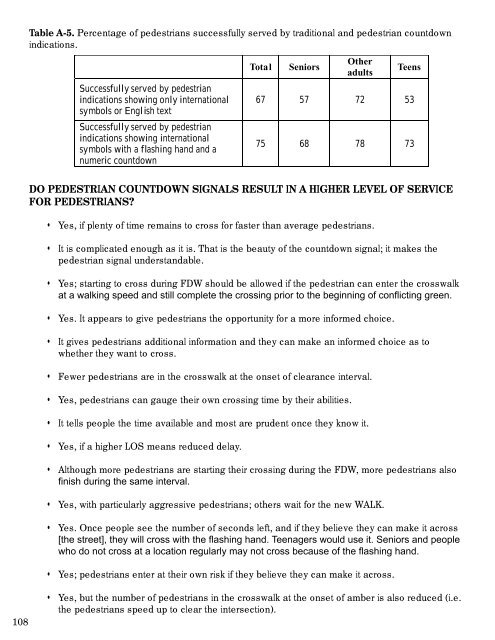Pedestrian Signal Safety - AAA Foundation for Traffic Safety
Pedestrian Signal Safety - AAA Foundation for Traffic Safety
Pedestrian Signal Safety - AAA Foundation for Traffic Safety
You also want an ePaper? Increase the reach of your titles
YUMPU automatically turns print PDFs into web optimized ePapers that Google loves.
108<br />
Table A-5. Percentage of pedestrians successfully served by traditional and pedestrian countdown<br />
indications.<br />
Successfully served by pedestrian<br />
indications showing only international<br />
symbols or English text<br />
Successfully served by pedestrian<br />
indications showing international<br />
symbols with a flashing hand and a<br />
numeric countdown<br />
Total Seniors<br />
Other<br />
adults<br />
Teens<br />
67 57 72 53<br />
75 68 78 73<br />
DO PEDESTRIAN COUNTDOWN SIGNALS RESULT IN A HIGHER LEVEL OF SERVICE<br />
FOR PEDESTRIANS?<br />
• Yes, if plenty of time remains to cross <strong>for</strong> faster than average pedestrians.<br />
• It is complicated enough as it is. That is the beauty of the countdown signal; it makes the<br />
pedestrian signal understandable.<br />
• Yes; starting to cross during FDW should be allowed if the pedestrian can enter the crosswalk<br />
at a walking speed and still complete the crossing prior to the beginning of conflicting green.<br />
• Yes. It appears to give pedestrians the opportunity <strong>for</strong> a more in<strong>for</strong>med choice.<br />
• It gives pedestrians additional in<strong>for</strong>mation and they can make an in<strong>for</strong>med choice as to<br />
whether they want to cross.<br />
• Fewer pedestrians are in the crosswalk at the onset of clearance interval.<br />
• Yes, pedestrians can gauge their own crossing time by their abilities.<br />
• It tells people the time available and most are prudent once they know it.<br />
• Yes, if a higher LOS means reduced delay.<br />
• Although more pedestrians are starting their crossing during the FDW, more pedestrians also<br />
finish during the same interval.<br />
• Yes, with particularly aggressive pedestrians; others wait <strong>for</strong> the new WALK.<br />
• Yes. Once people see the number of seconds left, and if they believe they can make it across<br />
[the street], they will cross with the flashing hand. Teenagers would use it. Seniors and people<br />
who do not cross at a location regularly may not cross because of the flashing hand.<br />
• Yes; pedestrians enter at their own risk if they believe they can make it across.<br />
• Yes, but the number of pedestrians in the crosswalk at the onset of amber is also reduced (i.e.<br />
the pedestrians speed up to clear the intersection).








